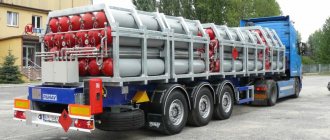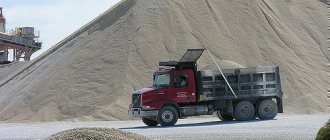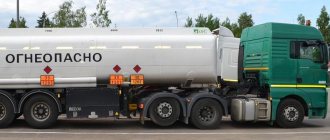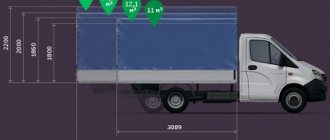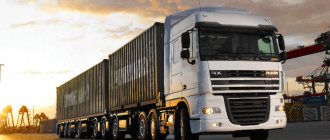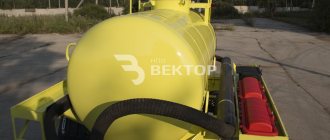Liquid cargo is a type of cargo for the transportation of which special types of transport are used (tanks, tank containers, cars, bunkers). Carriers are required to know the rules for transporting liquid cargo in bulk in tank cars and the conditions for their transportation and storage.
Tank containers are used for transporting liquid cargo
Classification
Liquid cargo is classified according to the following system:
- bulk products from the food industry;
- raw oil;
- petroleum products;
- chemical cargo: all types of varnishes and dyes, acids, alkalis and liquefied gases.
Goods transported by bulk methods are divided into groups:
- dangerous products, the transportation of which is carried out by special transport;
- non-hazardous products.
Liquid cargo can be both dangerous and safe
Obtaining Permits
To transport hazardous substances, you must obtain a special permit from Rostransnadzor. The document form is the same, but provides two transportation options:
- One-time. Permission is given only for one cargo transportation, which is carried out according to the route and specifics of the goods transported.
- Multiple. Issued for making several identical deliveries. A prerequisite is compliance with uniform qualitative and quantitative characteristics, as well as the same route. Valid for 6 months.
If the delivery scheme or category of goods changes, the carrier is required to obtain another permit.
The application must provide the following information:
- Full name of the company that will transport dangerous goods.
- Contacts and address of the actual location of the company.
- Hazard class according to international standards.
- Characteristics of the cargo (dimensions, weight, type of packaging).
- Vehicle type.
- Contacts of the sender and recipient of the cargo.
- Confirmation of the specified product category.
- Agreement between the cargo owner and the transport company.
- Consignment note (3 copies).
- A document confirming special training regarding the specifics of transporting dangerous goods.
- Admission to international cargo transportation.
Oil cargo
Oil is the most important industrial product. The calorific value coefficient is 1.5 times higher than the combustion coefficient of the highest quality coal varieties. Its cost is also attractive; it is 10 times lower than for coal.
Among liquid cargo, oil and petroleum products account for almost 90%. This list includes at least a hundred items. Delivery is carried out by various modes of transport, but pipeline transport is the most effective.
A whole system of requirements for loading and delivery of liquid cargo has been developed. If fuel oil is transported, then:
- it is necessary to have heating of the rolling stock;
- use of specialized tanks (bunker gondola cars);
- The tank boiler must be equipped with double walls.
When using sea delivery of goods from one port to another, the specifics of the port should be taken into account to ensure safety.
Transportation of petroleum products requires special safety measures
Transportation procedure
The SB CARGO company has extensive experience in transporting various types of dangerous goods. The list of works that the company’s employees will perform includes:
- Checking preliminary documents from the shipper.
- Determination of the hazard class and requirements for packaging and transportation of this cargo (for this, the shipper must provide a safety data sheet (MSDS for imported cargo) or specifications for the cargo).
- Preparation of permits for the movement of dangerous goods.
- Each order is supervised by a representative of SB CARGO, who at the preliminary stage agrees with the customer on the route and volume of the shipment.
- The specialist controls the process of checking the application of additional labeling (if required) and packaging of cargo depending on the hazard class.
- Delivery is carried out using the optimal transport for each type of cargo.
- Customs clearance is being carried out.
- Insurance options available.
Careful control of each order ensures successful delivery of cargo of different hazard classes to almost any foreign country. Forwarding is carried out, which guarantees delivery of goods intact and in the shortest possible time.
Specialized equipment is used to complete the order. Substances and objects that are dangerous to transport are securely secured in transport in such a way that the prospect of creating emergency situations when moving along roads with low-quality pavement and possible accidents is eliminated.
The company guarantees the preservation of storage conditions for each item depending on the requirements, for example, maintaining sub-zero ambient temperatures.
When working with dangerous goods, transportation experience and qualifications of specialists play an important role. The SB CARGO company provides special training for each employee, which is confirmed by relevant certificates.
Properties of petroleum products
Oil cargoes are characterized by a number of specific properties. Among them, the most significant are: flammability, electrification, explosiveness and toxicity.
Transportation of liquid cargo may be accompanied by natural loss. This is facilitated by a system of factors:
- product properties (chemical, physical);
- natural conditions (wind blowing, evaporation);
- design features of devices used for transportation.
Therefore, the initial volume of goods decreases, product quality is lost and the environment is polluted.
If open loading of oil products is carried out, then possible losses associated with evaporation amount to up to 0.1% of the total volume.
When providing logistics services for transporting liquid cargo by rail, losses can amount to up to 260 kg.
When transporting petroleum products by rail, losses due to evaporation can amount to up to 0.1% of volume
International agreements
There are now several international documents in force that regulate the process of transporting dangerous goods:
- UN Orange Book;
- Basel Convention;
- Rules for the transportation of radioactive substances developed by the International Atomic Energy Agency;
- Convention on Civil Liability for Damage in Situations Relating to the Transport of Dangerous Goods;
- Agreement on interstate transportation of discharge and dangerous cargo used by CIS countries.
Shipping
Petroleum products are transported in tank cars that meet a certain system of requirements:
- They must have a bottom drain for unloading products.
- Tanks can be unloaded using pumping units when draining is carried out using the top hatch.
- Chemical products are transported in specially equipped tanks.
- Food products are also transported in special tanks.
Bitumen is transported in bunkers equipped with double walls. Loading and unloading is carried out on tracks, ports and warehouses that are not suitable for widespread use. The shipment is accompanied by a quality certificate.
Regulations
In order to carry out the international transportation of dangerous goods, it is necessary to follow the norms and standards prescribed in special documents.
The rules for the international transport of dangerous goods are constantly changing and supplemented. The reason is the emergence of more advanced means of transportation and the development of new technologies.
Regulatory acts affecting the rules for transporting dangerous goods:
- UN recommendations;
- addition to the recommendations in the form of a manual of tests and criteria;
- standard rules and classification system for dangerous goods in force in a particular country.
Based on these documents, carriers plan the entire delivery route.
Acids
Acids are classified as dangerous chemical cargoes (hydrochloric, sulfuric). Acids are dangerous because they can:
- cause chemical burns;
- cause explosions;
- create a number of emergency situations.
Transportation of such goods requires compliance with special transportation conditions. Tanks are painted a certain color and equipped with special signs.
Acid tanks are painted in a bright warning color
Choosing the optimal route
At the stage of developing and coordinating a route for the transportation of chemical goods, specialists from the transport logistics department necessarily draw up several equivalent routes, from which the optimal one is then selected. The selection criteria include the length, the presence of restrictions on the passage of vehicles of the used carrying capacity, the likelihood of traffic jams, the intensity of traffic on the route and other important nuances.
Particular attention is paid to measures to clean tanks of chemical cargo residues. This is necessary to ensure that potentially hazardous reagents do not accumulate and come into contact with substances transported next time.
If you want to completely protect yourself from unforeseen situations and entrust the safety of your cargo to experienced specialists, pay attention to the offers of our company. We have been successfully operating in the market for more than 20 years, which has allowed us to accumulate certain experience and study the infrastructure of the road freight transportation market. Our specialists are constantly trained and improve their professional level, which allows us to stay afloat, successfully withstand competition and solve the most complex complex problems!
Alcohols
Characteristics of liquid cargo containing alcohol:
- flammability;
- high toxicity;
- explosion hazard;
- ability to accumulate static current;
- presence of narcotic properties;
- ability to expand.
Logistics services for the transportation of wine alcohol are carried out in tanks with a capacity of 50 cubic meters. As the temperature increases, alcohol expands, and as it decreases, it contracts. Therefore, it is necessary to have a special mark on the inside of the cap. The filling height line is drawn. It is allowed to exceed it no more than 15 cm.
Alcohol is transported in tanks specially designed for this purpose.
Procedure for sending an order
To place an order with SB CARGO, just contact a representative by phone or fill out an application on the website. A company representative will promptly contact the client to clarify the smallest nuances of order execution.
Each order is delivered strictly on time from the door of SB CARGO to the customer’s door. Cargo escort is provided throughout the entire route. Our specialists have extensive experience in preparing customs declarations when crossing state borders. Additional information is provided by phone.
Transportation of liquid food products
Vegetable oils represent one of the types of bulk products and are characterized by:
- ability to absorb odors;
- oxidize and lose their qualities;
- have a high tanning temperature of about 240⁰C;
- Most oils are characterized by solidification with a slight decrease in temperature (-10 to -16⁰С).
Based on these characteristics, oils are transported in special tanks with a bottom drain.
Fats are highly viscous cargo. Therefore, before draining it is necessary to warm it up.
Bulk goods are transported at the required temperature. Some types of products can turn from liquid to solid (chocolate, paraffin). A system of requirements for methods of transporting liquid food products has been developed.
A tank with a bottom discharge is used to transport food products.
What it is
Liquid cargo includes any liquids, including liquefied gas, which are transported not using piece containers, but using large tanks. Most often, such cargo transportation is carried out in tanks. They are the most convenient for transporting liquids. Moreover, each transported product may have certain transportation and storage conditions that must be adhered to. The question is what is being transported in this way. In most cases, transport companies transport:
- oil;
- petroleum products (various types of fuel);
- oils;
- liquefied gas;
- chemical liquids;
- food products in liquid form.
All cargoes differ from each other in viscosity and density. That is, the bulk cargo can be ordinary water or liquid asphalt prepared for construction work. Moreover, all these compounds are transported in special tanks. Also, liquid cargo (LC) is classified into two large categories:
- Dangerous. These are oil and some types of petroleum products, liquefied gas, chemical substances, etc. That is, we are talking about those mixtures and liquids that can cause damage to the environment, as well as the health and life of people.
- Non-hazardous or food grade. This is water, alcohol for the production of alcoholic beverages, milk, vegetable oils, etc. Here we are talking about all those liquid products that are used in the food industry.
Do not forget about the NG category, which require compliance with certain temperature conditions during transportation and storage. This may simultaneously include food liquids such as milk and some petroleum products. Let's give an example. Bitumen and asphalt definitely cannot be considered food liquids. But they are widely used in construction work. If the temperature regime is not observed, these compounds will harden in just a few hours, as a result of which they will become unsuitable for further use.
To maintain the cargo at the required temperature, tanks are equipped with heating or cooling systems. This depends on the specific characteristics and needs of the liquid being transported. Isothermal, that is, cooling tanks, are widely used in the transportation of perishable products.
Physico-chemical characteristics of the cargo
When choosing a tank and the type of transport on which liquid cargo will be delivered, special attention is paid to its physical and chemical properties. They can significantly influence the choice of transportation conditions, which is why each transport company is obliged to study in detail the parameters of the goods being transported. The following can be considered key.
- Density. This is an indicator of the ratio of mass to unit volume of a substance. As you know from physics lessons, density has a close relationship with temperature. When heating occurs, the volume of a liquid increases, but contracts when cooled. Therefore, the carrier carefully measures the temperature during filling and calculates the possibility of its increase during transportation. If the tank is filled completely and the cargo begins to heat up, this will lead to the NG attempting to find any cracks to escape. There have been cases when, due to excess pressure inside a sealed tank, it simply burst.
- Viscosity. It's fluidity. Largely affects how long the cargo will be poured into and out of the tank. Highly viscous loads require more time. They may also require additional heating or the use of special pumps.
- Freezing. Some cargoes have the property of solidifying at certain temperatures. These include the same liquid asphalts and bitumens. This factor should be taken into account when choosing suitable transport and organizing the filling and draining of liquids. Therefore, for a number of NG it is necessary to use heated tanks or cooling equipment.
- Volatility. Characterizes the presence of the vapor-generating function of a liquid under certain conditions. This means that a liquid can change into a gaseous state. This property is typical for petroleum products, gasoline, etc. There is a direct relationship between the substance itself and its type, the temperature of the gas and the ambient temperature. In many ways, the evaporation process can be influenced by atmospheric pressure, time of year and the presence of free surfaces inside the tank. This characteristic is taken into account in order to predict possible losses of part of the cargo during transportation, at the stages of storage, unloading, etc.
- Heat capacity. Determines the amount of heat expended to heat the liquid by 1 degree Celsius. Using this value, you can find out how much energy and time will be required to heat up to the required temperature, allowing you to drain or fill the load without problems.
- Flash point. The minimum temperature at which a mixture of liquid vapor and air under the influence of an open flame can ignite. This characteristic determines the level of fire danger of the NG. Therefore, it allows us to provide for the creation of optimal conditions for transportation. If we take the same petroleum products, then when filling them into tanks they try to use a temperature at least 10 degrees lower than the flash point.
- Possible ignition temperature. The lowest temperature indicator under which NG can spontaneously ignite without the presence of a flame or spark. An extremely important condition for selecting a suitable tank and for safe loading and unloading operations.
- Explosiveness. It is determined by the minimum content of NG vapors at which an explosion is possible under the influence of an open flame or hot objects. Directly affects the choice of transport and tank.
- Electrolysis level. The property of substances to accumulate static electricity. This potentially threatens the formation of electrical discharges with subsequent ignition, explosions, etc.
- Corrosiveness. This is the property of substances to eat metal. A characteristic feature of alkalis and acids. In order to avoid processes of corrosion of the tank body, when choosing containers, special designs that are resistant to corrosion are chosen.
- Toxicity. The ability of a liquid to negatively affect the human body. When working with them, you must strictly adhere to safety rules to avoid increasing the concentration of vapors of dangerous liquid cargo.
- Iodine and acid number. It poses a danger to food cargo, which may begin to oxidize due to contact with metals and other materials, which negatively affects the nutritional and taste characteristics. Therefore, when transporting food NG, tanks made with a special coating are used.
As you can see, there are a number of properties and characteristics that can significantly affect the safety and suitability of transported liquid cargo. Therefore, experienced carriers take into account all these parameters to select suitable containers and the transport itself.
Tank containers
Delivery of liquid cargo by sea is no less effective. The products arrive at the port, and then, using cars and rail tanks, are delivered to their final destinations for further storage. Tankers are most often used for transportation. It is advantageous in that with a larger carrying capacity of the vessel, there is a low cost of transportation from port to port.
Road transportation is carried out using special tank containers. A container is inserted into it and filled. A tank container is a tank fenced with a metal structure. It has the dimensions of the container and certain fastening elements.
Tanks can be divided into separate compartments, which makes it possible to transport different types of liquids at the same time. Transporting liquid cargo with tank containers is much more convenient, since there is no need to pump liquid, but simply reload the tank container or flexi tank. Delivery of goods in containers is much easier.
Before using special tanks, bunker cars and tank containers, a system of checking their technical serviceability must be organized. It is necessary to carry out regular tests for compliance with GOST requirements, technical conditions and operating rules. With the sea delivery method, the port must be equipped with special equipment for unloading liquid cargo.
When transporting liquid cargo, special safety conditions must be observed. This is facilitated by the correct qualification of products. After all, the slightest failure to comply with protective measures can lead to an extremely dangerous situation: explosion, fire or poisoning.
Transportation of liquid cargo by road
According to Rosstat, 5,404 million tons of cargo were transported by road in 2022. The total freight turnover for all types of transport amounted to 8071 million tons, that is, the share of road transport in all freight traffic was 67%.
For the transportation of liquids by road transport, the following are used:
- Tank trucks. Like railway tanks, road tanks differ in the type of liquid for which they are intended. The difference between tank trucks is manifested in the presence of a temperature regime and the design of its operation. A standard tank truck does not have a temperature regime. In hot weather, the liquid in it will quickly heat up, and in sub-zero temperatures such a tanker cannot be used, as the liquid cargo will freeze. For perishable liquids, an isotherm is suitable. An isotherm is a tank truck that can maintain the temperature of a liquid throughout the day. But even after 24 hours, the losses are small: for each subsequent day, the isothermal tank loses from one to three degrees Celsius. There is an isotherm with a steam jacket. As the name implies, such a tank is equipped with thermal equipment powered by hot steam. There is a tanker truck that maintains the desired temperature throughout the journey. Its temperature regime is called autonomous heating.
The most complex type of tank trucks are ADR tanks. For production, high-strength thickened steel is used. For petrochemicals, such tanks are equipped with control sensors that allow the driver to monitor its condition along the way. They are divided into nine classes, corresponding to the hazard class of the cargo for which the tank is manufactured.
- Flexitank. Polymer soft pillow-shaped container, installed in a standard 20-foot container. When folded, it takes up 0.25 m3, which saves space during storage and transportation. Holds from 14 thousand to 24 thousand liters of liquid. The outer shell of the flexitank is reinforced with metallized fabric. The flexitank is not intended for dangerous goods and must be disposed of after unloading. Installing a flexitank in a container, filling it and emptying it does not require special training, so it can be performed directly at the points of departure and arrival.
- Tank container. Tank containers are a kind of hybrid of a tank and a container. Consists of a tank and a frame based on a twenty-foot container. There are safe tank containers for transporting petroleum products and toxic substances. Due to their design, it is advantageous to use them in multimodal transportation, since it is possible to move a tank container from one type of transport to another without overflowing liquid.
Compared to rail, road transport is superior in door-to-door delivery. Not all regions have a railway line; often road transport is the only way to deliver liquid cargo.
General rules and requirements for the transportation of liquids
There are a number of general rules and requirements that must be taken into account when transporting liquid cargo. The recommendations are as follows:
- Containers for transporting liquids must be cleaned before each transport.
- Use the appropriate types of tanks for each type of cargo.
- The next scheduled repair or technical inspection should be no earlier than in a month.
- Check the integrity of tanks and securing hatches before shipment and during transportation.
- Eliminate the possibility of malfunctions of drain, shut-off and filling valves.
- Correctly set the temperature regime if this is necessary for the successful transportation of liquid cargo of a certain type.
Conscientious adherence to these points allows you to organize effective work and gain trust and a good reputation.
